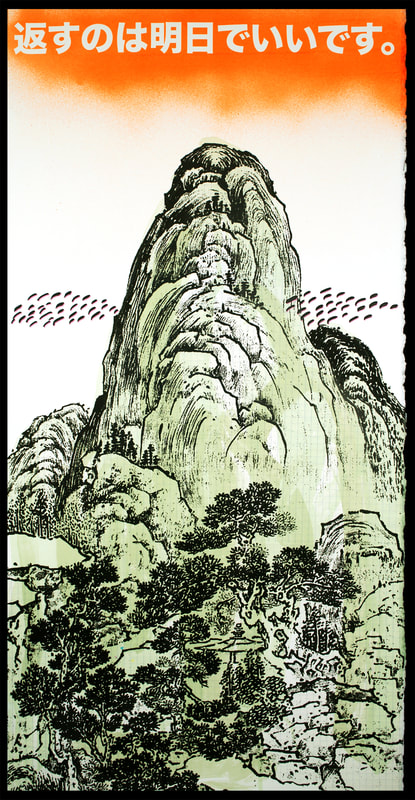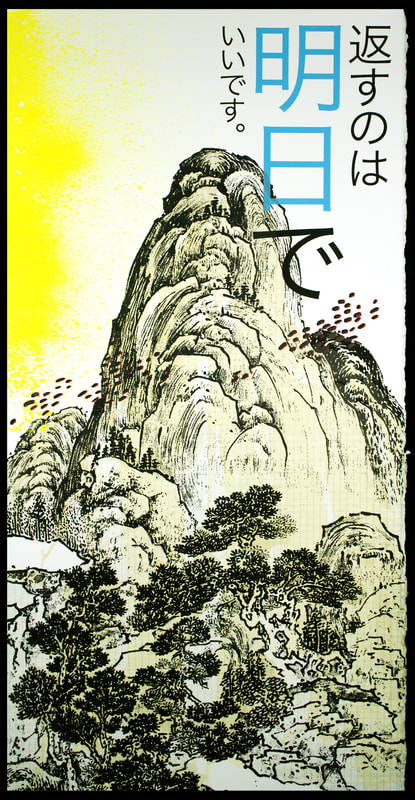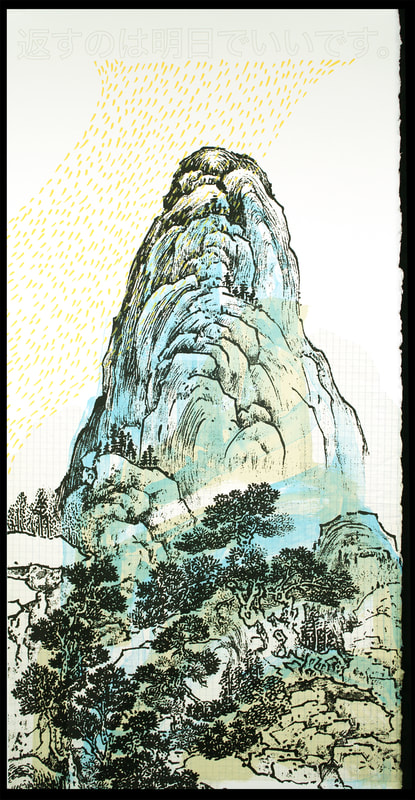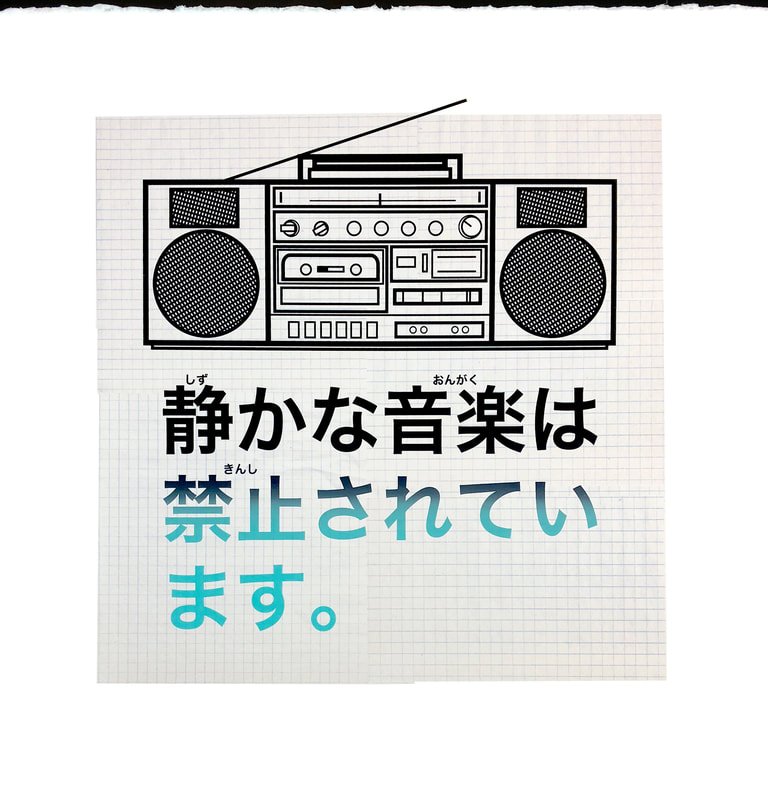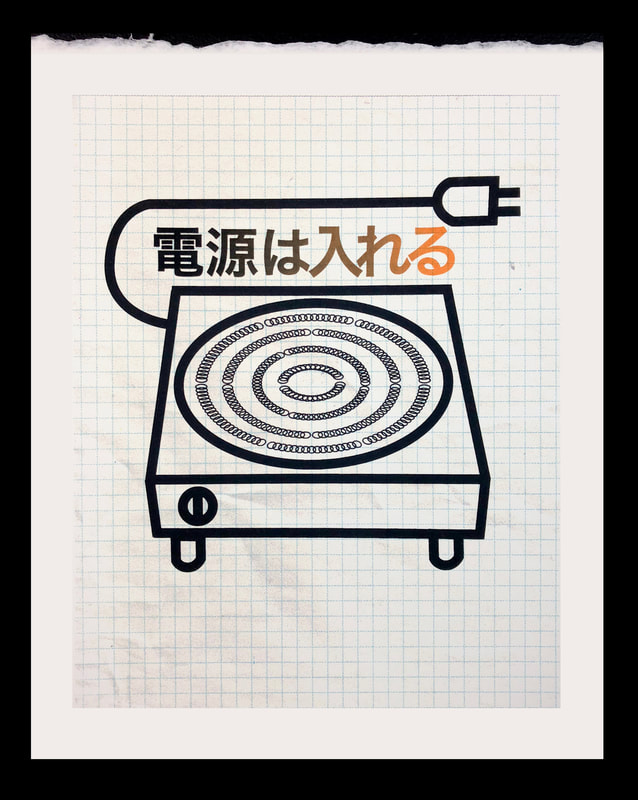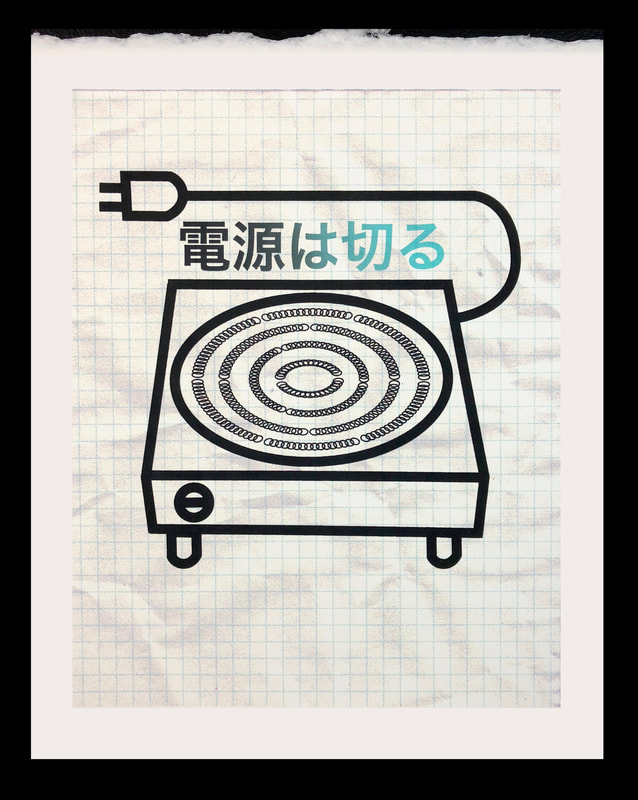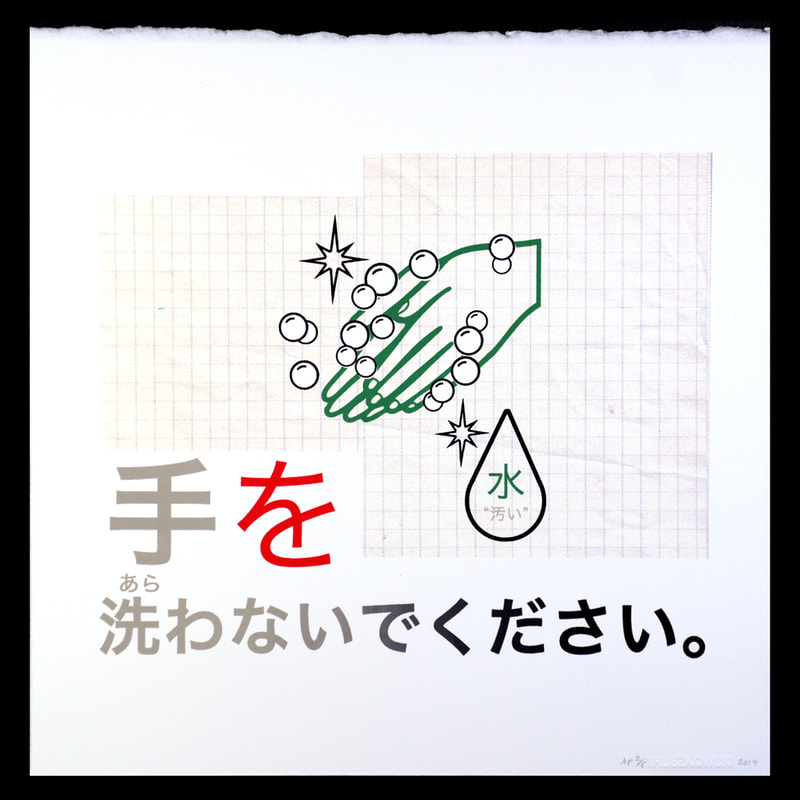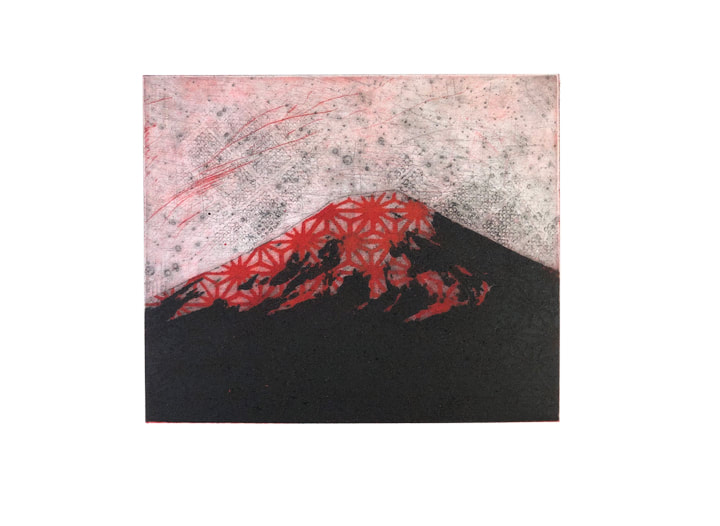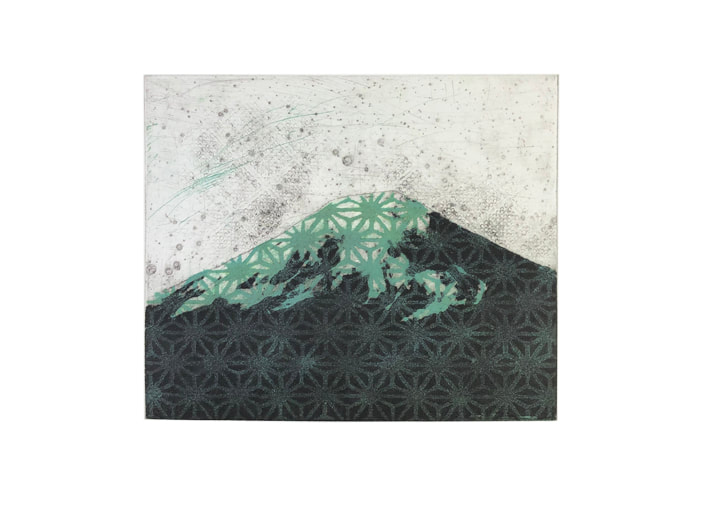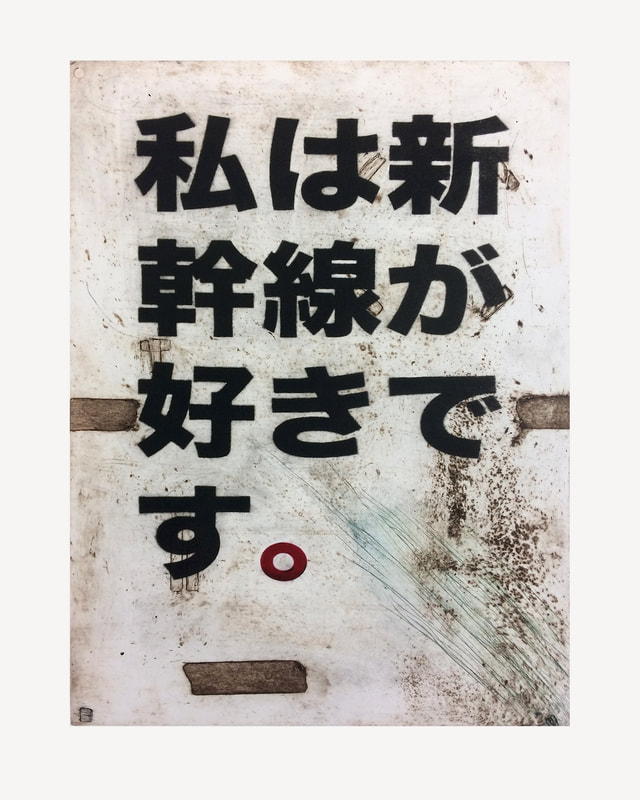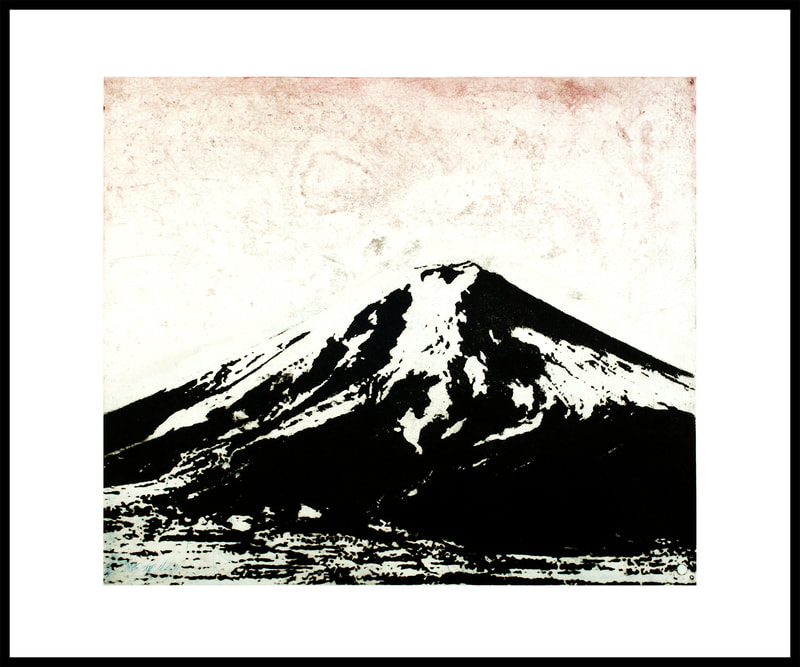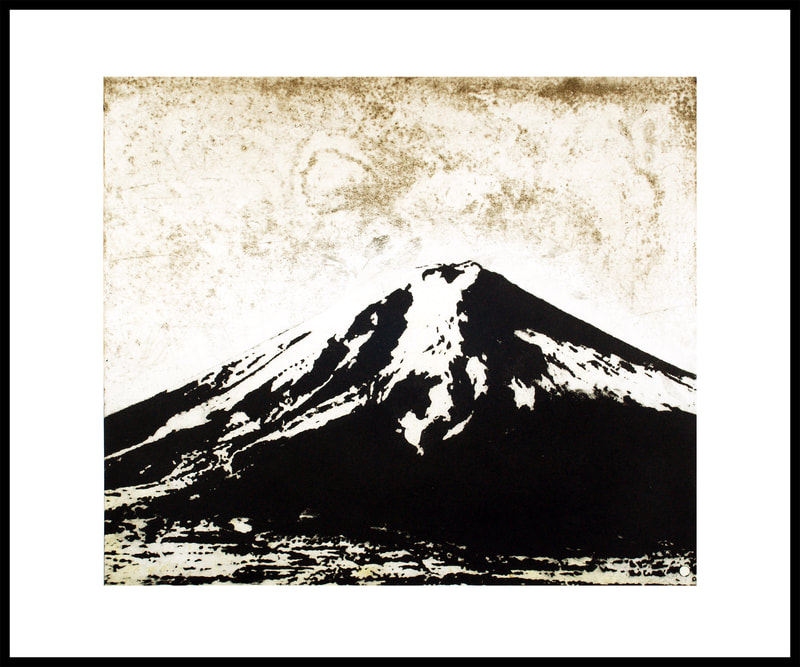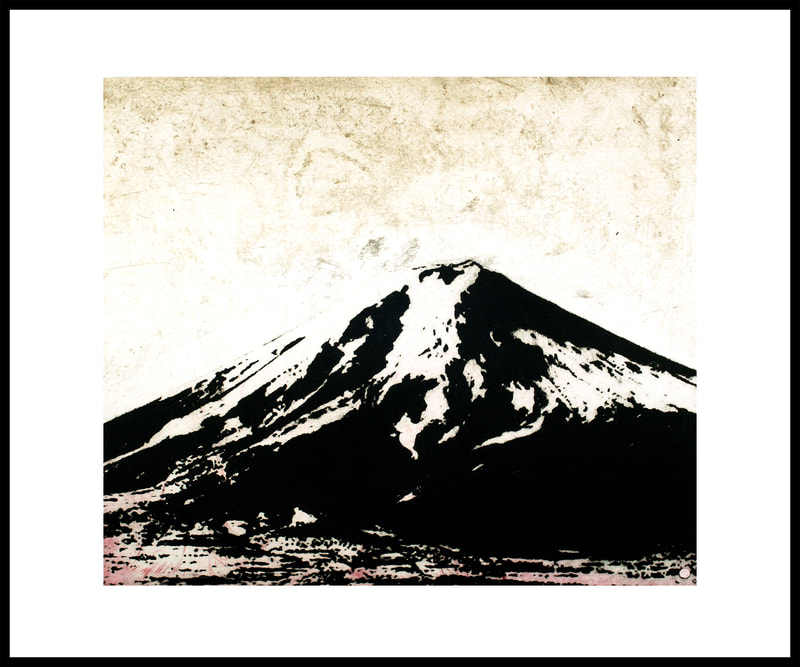Recent Work
Please click on images to see larger versions.
My current work is primarily UV Silkscreen Printmaking on paper. My process is very involved, whereby I work from hand-drawn and painted imagery, alongside digitally generated and mediated imagery. Typically, the photographic elements of the work have been produced through (my own) manual separation of colours, using digital editing software. Where commercially produced printed matter such as newspapers, magazines, and books are generated through the printing of four colours only (CMYK or "process colour"), my manual approach might separate imagery into 10-30 layers, for reconstitution in hand-printed silkscreen. A great deal of my Printmaking work – from 2007 to present – is composed of several such constituent "parts", and is consequently printed by hand in dozens and dozen of total colours.
The Ike No Taiga "Collaboration" Summer 2019
In April 2018, I attended the exhibition called "The Genius of Ike No Taiga 池大雅: Carefree Traveller, Legendary Painter" at the Kyoto National Museum. It was the first time, in a long time, that I was truly stunned by an art exhibition. The artist, dead for more than 200 years, was celebrated at the museum with hundreds of works, almost exclusively on paper; sometimes in the form of single sheets, or screens, sometimes, scrolls, but invariably delicate, embracing the "negative space" (to use a Western idiom) in the most sensitive way. I am ashamed to say that although my offspring moved through the galleries at a quick pace, begging to leave so we could have lunch, I stubbornly refused, choosing to move excrutiatingly slow, and taking it all in. Spending two uninterrupted hours in a museum does not happen often, for me, but this exhibition demanded it. Taiga's colours, fluid brush strokes, and use of text throughout was intoxicating to me, and in my usual fashion, I felt the need to collaborate!
Collaboration, of course, is very difficult when one of the parties is dead. "Sampling", as I discuss in other projects is the more appropriate descriptor, but being very visual in nature, I was deeply concerned that my work could look like appropriation. I turned to my own interest in colour and mark-making, as well as digital manipulation, to address how I would visually integrate Taiga's 250 year painting of a mountain to my aesthetic sensibility, along with the text of my personal Japanese study to connect that further, both in form and content. The text I have employed in each of the 6 pieces in this suite is the same, though rendered differently. "返すのは明日でいいです" (kaisu no wa, ashita de ii desu in phonetic Romaji, or "You can return it tomorrow") is a phrase taken from my daily Duolingo Japanese lessons, and in much the same way I sample musical lyrics, I have chosen to repeat it over and over. I think that there is something poetic about this phrase in particular, as it acknowledges "borrowing" (or "returning"), which is connected to sampling or appropriation, and deepens the conceptual connection I have been piecing together for many years, related to receipt and proof of communication. This specific suite of work, while just recently completed, is part of a larger project, still in progress, with conceptual and visual variations yet to come. The definitive text is not fully written.
Collaboration, of course, is very difficult when one of the parties is dead. "Sampling", as I discuss in other projects is the more appropriate descriptor, but being very visual in nature, I was deeply concerned that my work could look like appropriation. I turned to my own interest in colour and mark-making, as well as digital manipulation, to address how I would visually integrate Taiga's 250 year painting of a mountain to my aesthetic sensibility, along with the text of my personal Japanese study to connect that further, both in form and content. The text I have employed in each of the 6 pieces in this suite is the same, though rendered differently. "返すのは明日でいいです" (kaisu no wa, ashita de ii desu in phonetic Romaji, or "You can return it tomorrow") is a phrase taken from my daily Duolingo Japanese lessons, and in much the same way I sample musical lyrics, I have chosen to repeat it over and over. I think that there is something poetic about this phrase in particular, as it acknowledges "borrowing" (or "returning"), which is connected to sampling or appropriation, and deepens the conceptual connection I have been piecing together for many years, related to receipt and proof of communication. This specific suite of work, while just recently completed, is part of a larger project, still in progress, with conceptual and visual variations yet to come. The definitive text is not fully written.
Post-Kyoto Silkscreen Prints Summer 2018-present
Spending time in Kyoto, working in the Printmaking studios at a couple of friendly institutions, permitted me the opportunity to try to learn Japanese, with its three alphabets, and unfamiliar vocabulary, verb structures, and grammatical eccentricities, while processing this whole experience through one language that I know very well (and that spans the cultural and linguistic differences of Regina, Saskatchewan, and Kyoto, Japan); Printmaking. I began making work that was entirely text-based… luxuriating in the beauty of Japanese textual characters, and testing my weekly Japanese classes, and daily Japanese interactions, on silkscreens, plates, and printing presses. The first piece I completed in Kyoto was called “I like the Shinkansen” (Shinkansen means Bullet Train... see the work in the Kyoto Collographs, below). This was the first real, sensible sentence I was able to come up with on my own. Albeit simple, it embedded itself like a splinter in my brain, and I was smitten. I didn’t have to think about it, I knew it! Success!
Well, it’s not as easy as that, but it started me thinking more and more about the differences and the similarities of English and Japanese, and how I could position the minute successes against the almost inconceivably huge ocean of defeats. That is my favourite place to be, as an artist; right in the middle. I find humour (and irony, and pain, but also hope!) in this place, and that is what the work is about right now.
Practically-speaking, these works are UV silkscreen prints, all of which feature Japanese text, sometimes as individual pieces, sometimes as diptychs or tripychs, which for me, present the challenge of communicating; of understanding. Using the starting point of public signage, my imagery aims to present two similar, but very different imperatives or possible outcomes. “Please don’t play loud music” and “Please don’t play quiet music” are so, so similar (particularly through the lens of an unfamiliar language) but they mean different things. More importantly, who puts up a sign that asks one not to play their music quietly. It’s absurd… but why? This work will NOT answer that question, but it is the question itself, both literally, and as a stand-in for so much of the other cultural, social, and societal norms we take for granted that is important. Sometimes it’s a political act to simply ask why?
Well, it’s not as easy as that, but it started me thinking more and more about the differences and the similarities of English and Japanese, and how I could position the minute successes against the almost inconceivably huge ocean of defeats. That is my favourite place to be, as an artist; right in the middle. I find humour (and irony, and pain, but also hope!) in this place, and that is what the work is about right now.
Practically-speaking, these works are UV silkscreen prints, all of which feature Japanese text, sometimes as individual pieces, sometimes as diptychs or tripychs, which for me, present the challenge of communicating; of understanding. Using the starting point of public signage, my imagery aims to present two similar, but very different imperatives or possible outcomes. “Please don’t play loud music” and “Please don’t play quiet music” are so, so similar (particularly through the lens of an unfamiliar language) but they mean different things. More importantly, who puts up a sign that asks one not to play their music quietly. It’s absurd… but why? This work will NOT answer that question, but it is the question itself, both literally, and as a stand-in for so much of the other cultural, social, and societal norms we take for granted that is important. Sometimes it’s a political act to simply ask why?
Kyoto Collographs January - June 2018
My interest in working in a studio other than my own, centres around my desire to re-live some of my earliest experiences as a Printmaker. Before I had developed the set-up in my own studio at the University of Regina, with a very finely tuned workflow, I was a younger Printmaker who marvelled at every opportunity to walk into a new space. What I mean to say, is that I was looking to recapture the excitement of seeing possibilities in any studio regardless of how different they are from my own, however advanced or otherwise lacking, and to yearn to make work from that vantage point. The Studios at the Kyoto University of Art & Design, as well as at Seika University, are very well appointed. They have all of the presses, and related equipment and facilities that one needs. That being said, their screenprinting capabilities fall considerably short of my own arrangement at the University of Regina. Rather than focus on this fact, I looked for ways to make art that was genuine to me in terms of both form and content.
As with almost everything I make, my work begins with text. I was studying in a Japanese class each week, and of course, living in and navigating my personal life in the heart of Kyoto. I was much more than a tourist, in that I had a family to both help and protect, as well as be inspired by, along with a small house, friendly and inquisitive neighbors, and all the realities of a quotidien life... getting groceries, shopping for clothes, eating in restaurants, dealing with the municipal electrical company...
The first sentence that I was ever able to form in Japanese, at least in my own mind, was "I like the Shinkansen (bullet train)". I took this text, which incidentally, was ringing repeatedly in my head all day - on my daily bike ride to the university, or in bed as I dozed - and I applied it to a silkscreen. From there I screenprinted white glue onto recycled aluminum litho plates. Flocking the glue with stone litho abrasives, spraying with laquer, and then reworking the plate like a drypoint, I created very tactile "carborundum collograph" plates. Rather than thinking about making editions of prints in the conventional way, I revelled in the opportunity to ink plates differently each time, exploring colour and transparency, in a way I had not done in many many years. This first piece lead to other text-based works, and each time I was drawing upon language that I was learning and internalizing. For example, as in "My children's dog ate your cat's sandwich". I was very pleased with this piece for number of reasons, not the least of which was that my own sense of humour seemed to be coming through in a language that was still very new to me. The students and faculty members at the university who watched me print these plates, couldn't help but smile or laugh, despite the overarching imperative of Japanese society being to preserve respect and dignity at all costs. This was my first breakthrough!
I continued to work with text through my time in Japan, but almost like a magnet, I was attracted to patterns and motifs in Japanese arts and culture, and use the relative freedom of this experience to experiment further with how I might engage. I had a mind blowing experience on the bullet train to Tokyo, when I witnessed Mount Fuji from the window. It was a beautiful day, blue sky, and there was Fuji-san! As a result of this, and my other daily excursions to places of cultural significance around Kyoto, and indeed Japan, I made a small series of Mount Fuji collographs, using multiple plates, integrating some traditional patterns that I sampled from fabric I bought at the market. I want on to make much larger versions of these pieces, and aside from starting to perfect my technical process in this regard, the sheer physicality in making this work, and the experimentation I had permitted myself in both form and content, was immeasurably beneficial to me. Leaving Japan, I left this working method behind as well, because in a way, to compartmentalize the experience, is to protect it. Returning to my own studio, I really begin the debriefing process, using silkscreen and my array of tricks to synthesize the lessons of language and communication of my time away.
As with almost everything I make, my work begins with text. I was studying in a Japanese class each week, and of course, living in and navigating my personal life in the heart of Kyoto. I was much more than a tourist, in that I had a family to both help and protect, as well as be inspired by, along with a small house, friendly and inquisitive neighbors, and all the realities of a quotidien life... getting groceries, shopping for clothes, eating in restaurants, dealing with the municipal electrical company...
The first sentence that I was ever able to form in Japanese, at least in my own mind, was "I like the Shinkansen (bullet train)". I took this text, which incidentally, was ringing repeatedly in my head all day - on my daily bike ride to the university, or in bed as I dozed - and I applied it to a silkscreen. From there I screenprinted white glue onto recycled aluminum litho plates. Flocking the glue with stone litho abrasives, spraying with laquer, and then reworking the plate like a drypoint, I created very tactile "carborundum collograph" plates. Rather than thinking about making editions of prints in the conventional way, I revelled in the opportunity to ink plates differently each time, exploring colour and transparency, in a way I had not done in many many years. This first piece lead to other text-based works, and each time I was drawing upon language that I was learning and internalizing. For example, as in "My children's dog ate your cat's sandwich". I was very pleased with this piece for number of reasons, not the least of which was that my own sense of humour seemed to be coming through in a language that was still very new to me. The students and faculty members at the university who watched me print these plates, couldn't help but smile or laugh, despite the overarching imperative of Japanese society being to preserve respect and dignity at all costs. This was my first breakthrough!
I continued to work with text through my time in Japan, but almost like a magnet, I was attracted to patterns and motifs in Japanese arts and culture, and use the relative freedom of this experience to experiment further with how I might engage. I had a mind blowing experience on the bullet train to Tokyo, when I witnessed Mount Fuji from the window. It was a beautiful day, blue sky, and there was Fuji-san! As a result of this, and my other daily excursions to places of cultural significance around Kyoto, and indeed Japan, I made a small series of Mount Fuji collographs, using multiple plates, integrating some traditional patterns that I sampled from fabric I bought at the market. I want on to make much larger versions of these pieces, and aside from starting to perfect my technical process in this regard, the sheer physicality in making this work, and the experimentation I had permitted myself in both form and content, was immeasurably beneficial to me. Leaving Japan, I left this working method behind as well, because in a way, to compartmentalize the experience, is to protect it. Returning to my own studio, I really begin the debriefing process, using silkscreen and my array of tricks to synthesize the lessons of language and communication of my time away.
